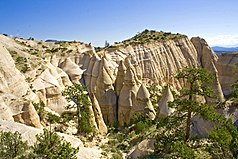Kasha-Katuwe Tent Rocks National Monument
| Kasha-Katuwe Tent Rocks National Monument | ||
|---|---|---|
| Rock cone in the reserve | ||
|
|
||
| Location: | New Mexico , United States | |
| Specialty: | Bizarre rock formations | |
| Next city: | Santa Fe | |
| Surface: | 16.7 km² | |
| Founding: | January 17, 2001 | |
Kasha-Katuwe Tent Rocks National Monument is a small national monument- type nature reserve in the US state of New Mexico . It protects a desert valley with bizarre forms of erosion in volcanic rock. President Bill Clinton dedicated it in his final days in 2001 and entrusted its administration to the Bureau of Land Management , an agency under the umbrella of the US Department of the Interior .
The name Kasha Katuwe means "white cliffs" in the language of the Pueblo Indians of the region.
description
The National Monument is located on the Pajarito Plateau in Sandoval County in northern New Mexico. About 7–6 million years ago the volcanoes of the Jemez volcanic fields to the west of today's protected areas emitted volcanic ash , pyroclastic currents left a layer of pumice and tuff several hundred meters thick , which where it was not protected by harder layers was quickly eroded . In the protected area there is a valley cut a maximum of 180 m deep, in the middle part of which there are tent-shaped rock cones on the flanks . Like the valley itself, they were created by erosion of the soft rock.
From the parking lot, an approximately 2 km long paved circular path leads through the lower part of the valley. In the back, a 1.8 km long unpaved path leads through a slot canyon and ascends to the plateau, from which one has a view over the valley with the erosion forms and the neighboring chains of the Jemez Mountains and Sangre de Cristo Mountains . This part is closed when it rains on the plateau.
Several species of juniper and pine grow in the area , including pinyon and yellow pine . Manzanita bushes form the undergrowth . Currant bushes in more sheltered places . The fauna includes the great spotted falcon , golden eagle , red-tailed buzzard , wild turkey and various species of swallows , as well as coyotes , elk , mule deer , ground squirrels and several species of lizards .
A settlement of the area can be proven for about 4000 years, in the 14th and 15th centuries Indians of the Pueblo culture built small settlement buildings made of adobe adobe bricks and rough stones. As early as the 1990s, the hiking trail through the area was designated as a National Recreation Trail . The Bandelier National Monument and its famous Painted Cove are in the immediate vicinity, but the areas do not touch and there is also no direct connection through the mountain range in between.
The area is accessed from Interstate Highway I 25 southwest of Santa Fe via a spur road through the area of the Cochiti Indians, who reserve the right to block their reservations for all outsiders on the occasion of special celebrations. In this case it is not possible to visit the area.
Web links
- Bureau of Land Management: Kasha-Katuwe Tent Rocks National Monument (official site )
- Kasha-Katuwe Tent Rocks National Monument on the sides of a coalition of conservation organizations
- Hike the Tent Rock National Recreation Trail in the Kasha-Katuwe Tent Rocks National Monument







